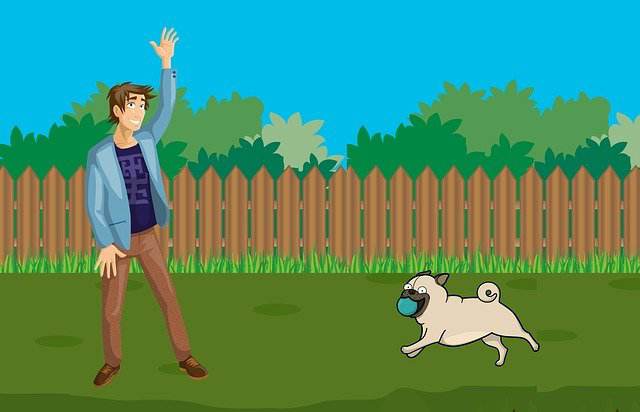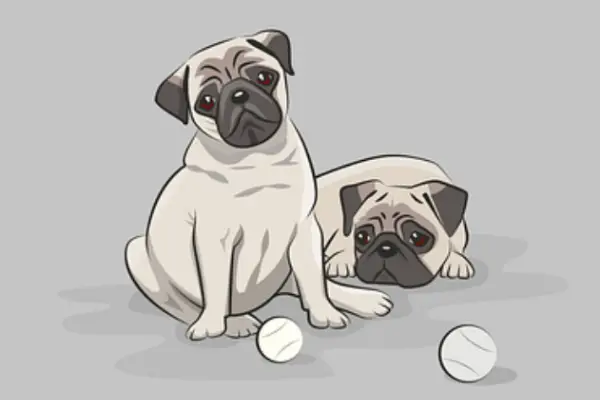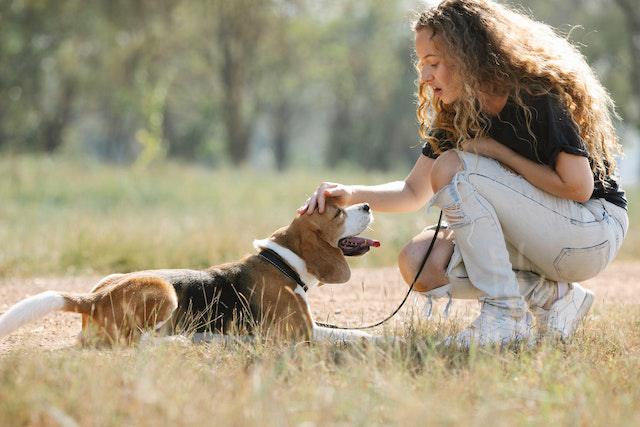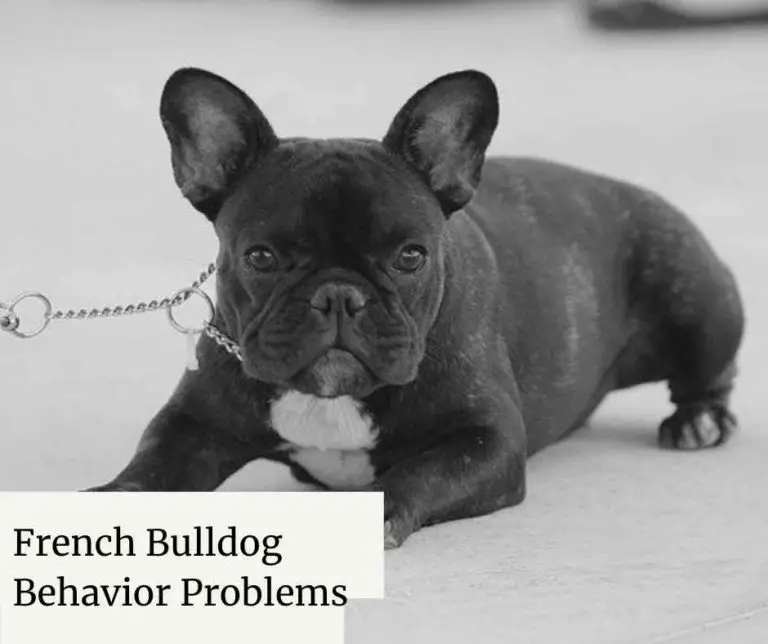Identifying Possessive Aggression in Dogs & Fixing It

Today, let’s talk about a common issue that can sometimes leave us scratching our heads: possessive aggression in dogs.
You know, that intense protectiveness they display over their toys, food, or even their favorite spot on the couch.
Well, in this post, we’ll delve into the causes, signs, and some handy tips to help curb this behavior.
So, let’s get to it!
What is Possessive Aggression in Dogs?
Possessive aggression in dogs refers to a behavior where they become protective or possessive over their resources, such as food, toys, or even their favorite spot on the couch.
This behavior can manifest as growling, snapping, or even biting when someone or another animal tries to approach or take away their possessions.
Read more about the forms of dog aggression.
Causes of Possessive Aggression in Dogs
There are several major causes that can contribute to possessive aggression in dogs.
Here are some of them:
1. Resource Guarding instincts: Resource guarding is a common cause of possessive aggression in dogs. It occurs when a dog perceives a resource, such as food, toys, or a resting place, as valuable and feels the need to protect it from others. This behavior can escalate into aggression if the dog feels threatened or if it believes that its resources are being taken away.
2. Lack of Socialization: Dogs that have not been properly socialized may exhibit possessive aggression. When dogs are not exposed to a variety of people, animals, and environments during their critical socialization period, they may become fearful or anxious in new situations. This fear or anxiety can manifest as possessive aggression when they feel the need to protect themselves or their resources.
3. Fear and Insecurity: Dogs that are fearful or insecure may display possessive aggression as a way to cope with their perceived threats. When a dog feels threatened or lacks confidence, it may resort to aggression to establish control and protect its resources.
4. Learned Behavior: Dogs can learn possessive aggression through reinforcement or observation. If a dog has been rewarded for displaying possessive behavior in the past, it may continue to exhibit aggression in similar situations. Additionally, dogs can learn possessive aggression by observing and imitating the behavior of other dogs or animals.
5. Lack of Training and Boundaries: Dogs that have not received proper training and guidance may be more prone to possessive aggression. Without clear boundaries and consistent training, dogs may not understand appropriate behavior around resources and may resort to aggression to assert control.
6. Genetics and Breed Predisposition: Some dog breeds may have a genetic predisposition towards possessive aggression. Certain breeds may be more prone to guarding behaviors due to their breeding history or specific traits. However, it’s important to note that genetics alone do not determine a dog’s behavior, and proper training and socialization can help mitigate any potential issues.
7. Underlying Medical Issues: In some cases, possessive aggression in dogs can be linked to underlying medical issues. Pain or discomfort can contribute to increased aggression, as dogs may become more protective of their resources when they are in pain. It’s important to rule out any medical conditions that may be contributing to the aggression and consult with a veterinarian if necessary.
8. Previous Negative Experiences: Dogs that have had negative experiences in the past, such as being deprived of resources or being threatened, may develop possessive aggression as a defensive response. These negative experiences can create a heightened sense of protectiveness.
Read more about what causes dog aggression.
Signs of Possessive Aggression in Dogs
Here are some signs of possessive aggression in dogs:
1. Resource Guarding Behavior: Dogs with possessive aggression may exhibit resource guarding behavior, which involves growling, snapping, or biting when someone approaches their food bowl, treats, toys, or other valuable items. They may also guard their sleeping area or favorite spots in the house.
2. Territorial Behavior: Dogs with possessive aggression may display territorial behavior, where they become aggressive when someone enters their perceived territory, such as their home or yard. They may bark, growl, or lunge at intruders or visitors.
3. Guarding Behavior: Dogs with possessive aggression may exhibit guarding behavior by protecting their owners or family members. They may become aggressive when someone approaches their owner or tries to interact with them.
4. Possessiveness Over People: Dogs with possessive aggression may show possessiveness over people, especially their owners or primary caregivers. They may become aggressive when someone tries to touch or get close to their owner, displaying protective behavior.
5. Aggression During Handling: Dogs with possessive aggression may display aggression during handling or grooming. They may resist being touched, groomed, or restrained, and may show signs of aggression, such as growling or biting, when these activities are attempted.
6. Aggression Over Space: Dogs with possessive aggression may become aggressive when their personal space is invaded. They may react aggressively if someone tries to move them from their preferred spot or if they feel crowded in a confined space.
7. Unwillingness to Share: Dogs with possessive aggression may show an unwillingness to share their resources with other dogs or animals. They may display aggressive behavior when another dog or animal approaches their food, toys, or other possessions.
8. Intense focus on possessions: Dogs with possessive aggression may exhibit intense focus and obsession with their possessions. They may constantly keep an eye on their resources, become anxious or agitated if someone gets too close, and display signs of stress or tension.
Read more about identifying dog aggression.
How to Stop Possessive Aggression in Dogs
Possessive aggression in dogs, also known as resource guarding, is a behavior where a dog becomes protective of certain items or spaces and displays aggressive behavior to defend them.
It is important to address possessive aggression in dogs to ensure the safety of both the dog and the people around them.
Here are some practical ways to stop possessive aggression in dogs:
1. Identify Triggers and Avoidance
Identify the specific triggers that cause possessive aggression in your dog. These triggers can include food, toys, bones, or specific areas in the house.
Once you have identified the triggers, try to avoid or minimize your dog’s exposure to them to prevent aggressive behavior.
2. Positive Reinforcement Training
Implement positive reinforcement training techniques to teach your dog alternative behaviors. Reward your dog for displaying calm and non-aggressive behavior in situations that would typically trigger possessive aggression. Use treats, praise, and rewards to reinforce positive behavior.
3. Desensitization and Counterconditioning
Gradually expose your dog to the triggers that cause possessive aggression in a controlled and positive manner. This process is known as desensitization.
Pair the presence of the trigger with something positive, such as treats or playtime, to create positive associations. This is called counterconditioning.
Over time, your dog will learn to associate the trigger with positive experiences, reducing possessive aggression.
4. Trade and Exchange
Teach your dog to willingly give up items they are possessive of by using a trade and exchange method.
Offer a high-value treat or toy in exchange for the item your dog is guarding. This helps your dog understand that giving up the item leads to a positive outcome.
5. Management and Environmental Modifications
Implement management strategies to prevent possessive aggression situations from occurring.
This can include keeping valuable items out of your dog’s reach, using baby gates or crates to create safe spaces, and separating dogs during meal times or when valuable resources are present.
6. Consistency and Predictability
Establish consistent rules and routines for your dog to create a sense of predictability.
Dogs thrive on routine and knowing what to expect. Consistency in training and daily interactions can help reduce possessive aggression.
7. Seek Professional Help
If possessive aggression in your dog persists or escalates despite your efforts, it is important to seek professional help from a qualified dog behaviorist or trainer.
They can assess the situation, provide personalized guidance, and develop a behavior modification plan tailored to your dog’s specific needs.
Remember, addressing possessive aggression in dogs requires patience, consistency, and positive reinforcement. It is essential to prioritize the safety of all individuals involved and seek professional guidance when needed.
Read more about fixing dog aggression.
Preventing Possessive Aggression in Dogs
Here are some practical ways to prevent possessive aggression in dogs:
1. Early Socialization and Training: Early socialization and training are crucial in preventing possessive aggression in dogs. Expose your dog to various people, animals, and environments from a young age to help them develop positive associations and reduce the likelihood of possessive behavior.
2. Positive Reinforcement Training: Use positive reinforcement training methods to teach your dog basic obedience commands and reward them for good behavior. This helps establish a strong bond between you and your dog and promotes positive behavior.
3. Avoid Punishment-Based Training: Avoid using punishment-based training methods as they can increase fear and anxiety in dogs, potentially exacerbating possessive aggression. Instead, focus on positive reinforcement and reward-based training techniques.
4. Manage Resources: Manage your dog’s resources to prevent possessive behavior. This includes providing separate feeding areas, using food puzzles or interactive toys to make mealtime more engaging, and gradually desensitizing your dog to people approaching their food or toys.
5. Teach “Drop It” and “Leave It” Commands: Teach your dog reliable “drop it” and “leave it” commands. These commands can help redirect their attention away from objects they may guard and encourage them to release or let go of items willingly.
6. Trade-Up Strategy: Implement a trade-up strategy by offering your dog something of higher value in exchange for the item they are guarding. This helps teach them that giving up an item results in receiving something even better, reducing possessive behavior.
7. Consult a Professional If Needed: If your dog’s possessive aggression persists or escalates despite your efforts, it is important to seek guidance from a professional dog trainer or behaviorist. They can assess the situation, provide personalized advice, and develop a behavior modification plan tailored to your dog’s specific needs.
Remember, preventing possessive aggression in dogs requires patience, consistency, and positive reinforcement.
By implementing these practical strategies and seeking professional help when needed, you can help your dog overcome possessive behavior and create a safer and happier environment for everyone involved.
Read more about strategies for preventing dog aggression.
Frequently Asked Questions
Why do dogs display possessive aggression?
Dogs may display possessive aggression due to a variety of reasons. It could be a result of fear or anxiety, a lack of proper socialization, past traumatic experiences, or even a genetic predisposition. It’s important to understand that each dog is unique, and their behavior can be influenced by a combination of factors.
How can I recognize possessive aggression in my dog?
Recognizing possessive aggression in dogs involves observing their behavior closely. Signs may include growling, snarling, snapping, or biting when someone approaches their belongings. They may also show stiff body language, guarding behavior, or excessive attention towards their possessions. If you notice these signs, it’s essential to address the issue promptly.
Can possessive aggression in dogs be treated or managed?
Yes, possessive aggression in dogs can be treated or managed with the help of a professional dog trainer or behaviorist. They can assess your dog’s behavior, create a behavior modification plan, and provide guidance on training techniques. It’s important to remember that consistency, patience, and positive reinforcement are key when working with possessive aggression.
How can I prevent possessive aggression in my dog?
Preventing possessive aggression in dogs starts with proper socialization from an early age. Expose your dog to different people, environments, and situations to help them develop confidence and reduce fear or anxiety. Additionally, teaching your dog basic obedience commands, such as “leave it” or “drop it,” can also be helpful in preventing possessive behavior.
Should I punish my dog for possessive aggression?
It’s important to avoid punishing your dog for possessive aggression. Punishment can worsen the behavior and create more fear or anxiety in your dog. Instead, focus on positive reinforcement training techniques, rewarding good behavior, and seeking professional help if necessary. Remember, building trust and a positive relationship with your dog is essential in addressing possessive aggression.
Conclusion
In conclusion, it’s crucial for us pet owners to address possessive aggression in dogs with patience and understanding.
By recognizing the signs and implementing positive reinforcement training, we can help our furry friends overcome this behavior and create a harmonious environment at home.
Remember, with proper guidance and love, we can nurture a happy and well-balanced pet who will bring us endless joy and companionship.


![Are Boston Terriers Aggressive [Useful Tips] Are Boston Terriers Aggressive](https://petcreeks.com/wp-content/uploads/2022/11/Are-Boston-Terriers-Aggressive-768x555.jpg)

![Dog Desensitization Training [How & When to Use] Dog Desensitization Training](https://petcreeks.com/wp-content/uploads/2023/12/pexels-sarah-chai-7282827.jpg)

